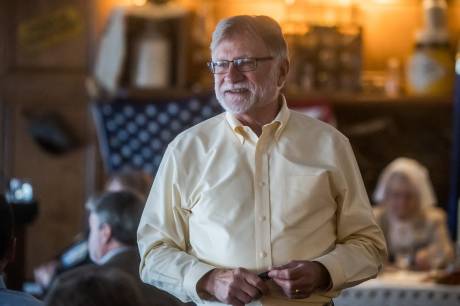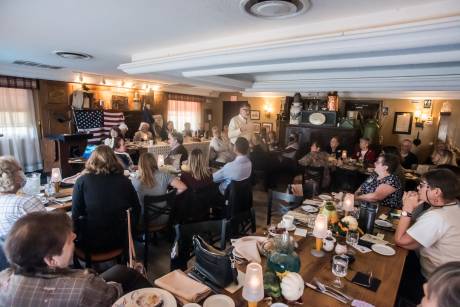
Local educator Greg Kinal was a featured speaker about immigration for a gathering of the Daughters of the American Revolution Saturday at Red Osier Landmark Restaurant in Stafford.
Kinal, who taught social studies at Pembroke High School for 52 years as well as teaching at GCC, shared how immigration shaped the nation. He drew from his own family history to illustrate the hardships, the foods, and the customs of immigrants.
Saturday's meeting brought together members and leaders from DAR's 13 chapters in the State of New York and celebrated “Hearth and Home,” the role of Deputy Husbands during the American Revolution.
The meeting was hosted by the Daughters of the American Revolution Anna Ingalsbe Lovell Chapter #1197 of Genesee County. More than 60 members attended.
DAR officials in attendance were Vice President General Patrice Briner, State Chaplain Penny Nice, and Kay Green, state librarian. Also honored were state chairs Deborah Lee Ayers, NYS National Defense, Tammy Lachner, C.A.R. senior, and Joan Sinclair, District VIII director. Daughters with national appointments included Melody Joy Burow, representative VAVS at Buffalo, Margaret Z. Haney, deputy representative VAVS Buffalo, and Pamela J. Ware, representative VAVS Batavia.
Assemblyman Steve Hawley was the keynote speaker and presented a proclamation honoring “Deputy Husbands.”
During the revolution, deputy husbands were the women who stayed at home while the men joined the battle. The term comes from a book by Thomas Fuller, "The Holy and the Profane State" (1642), a woman “in her husband’s absence, is a wife and deputy-husband, which makes her double the files of her diligence.”
Local President Pam Ware said, "Colonial records yield evidence of female blacksmiths, silversmiths, shoemakers, shipwrights, tanners, gunsmiths, barbers, butchers, teachers, and shopkeepers. Wives were responsible for operating the family farms and businesses, raising and educating their children, supervising the workers, harvesting, and purchasing and selling of crops and livestock. Wives would transact business, settle accounts, and even initiate court proceedings."
Printers, of considerable importance, Ware said, included Mary Katherine Goddard (1738–1816). Upon receiving word from the Second Continental Congress to print and widely distribute the Declaration of Independence, Goddard set to work in 1777, printing her copy with the added typeset names of the signatories, including John Hancock. Hers was the first copy to bear all of the signers’ names. This Goddard Broadside was proudly labeled: Printed by Mary Katherine Goddard.
Two members of the Pembroke Veterans Outreach Club, Lilly Senko, who read the Proclamation from State Senator Ed Rath, and Amelia Geck, who read the Proclamation from the Genesee County Legislature, courtesy of Gordon L. Dibble.
Matt Moscato, Advisor to the PVOC, presented a slide show of the origin and success stories of how the PVOC students honor and support the Pembroke school’s military service personnel with the Wall of Honor, the C. Jay Hall Memorial Highway, the annual Wreaths across America at the National Cemetery in Indian Falls, numerous outreach programs, and fundraising events.
Membership in DAR is open to (from the DAR website) "any woman 18 years or older, regardless of race, religion, or ethnic background, who can prove lineal descent from a patriot of the American Revolution."
Ware said it's a rigorous process and prospective members must provide documentation for each member of the family tree dating back to the person, or persons, who fought in the Revolutionary War. The process can take more than a year.
Press release material contributed to this story. Photos by Howard Owens.

